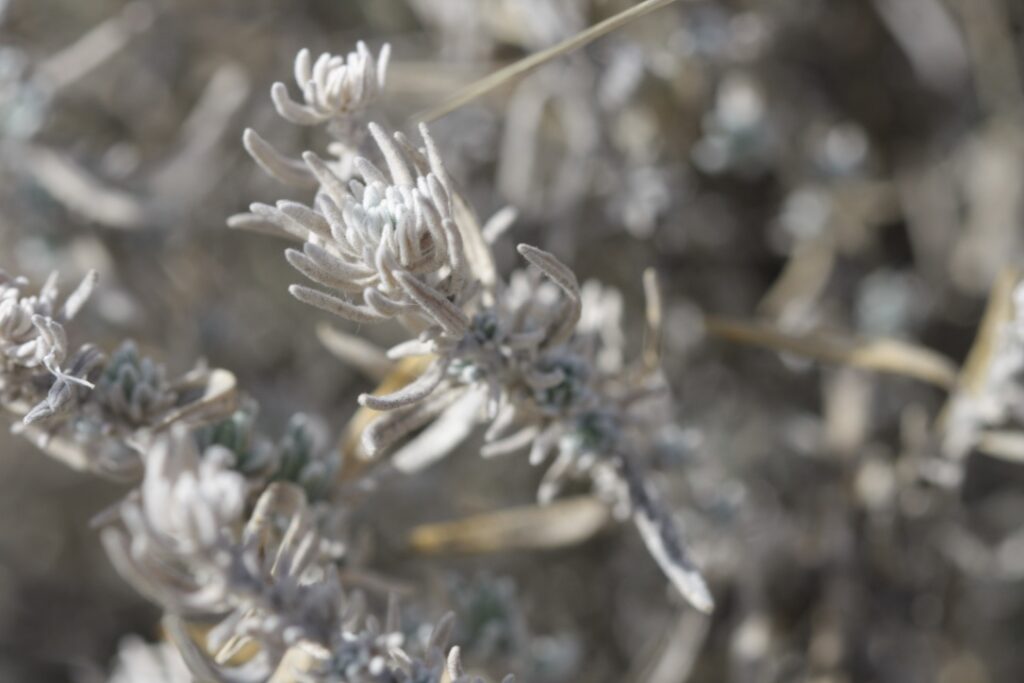Winterfat – Krascheninnikovia lanata (Pursch) A.D.G. Meeuse & Smit
Family Amaranthaceae

Synonyms or Other Names:
- Ceratoides lanata
- Eurotia lanata
- Diotis lanata
- Eurotia lanata ssp. subspinosa
Its other common names include White Sage and Wintersage.
Origin & Status
Common. Native to North America.
Notable Features to Identify:
This short prairie shrub (30 to 90 cm tall) grows with a woody base (greyish-brown) and white-rusty deciduous erect stems. The flat, lanceolate leaves (growing up to 3 cm long) are most notable for their in-rolled margins observed on their undersides. The plant is covered in fine star-shaped hairs that age to a reddish colour. New stems regrow from old crowns beneath, with the stems having a reddish colour.
This species is monoecious, with male flowers (staminate) on the top of the plant and females (pistillate) below; the female flowers have dense, long white hairs on the bracteoles, giving K. lanata a very fuzzy appearance during blooming.
When & Where to Find This Plant
Winterfat is primarily found in the Prairie Ecoregion. However, it can also be found in the most arid areas of the Foothills and Parkland regions. It favours the dry grasslands, desert shrub and sagebrush plant communities where conditions remain hot and dry. It particularly favours saline and alkaline soils that often contain heavy clay.
You will find this shrub in the Pascopyrum–Hesperostipa and Bouteloua–Pascopyrum–Hesperostipa plant communities. In addition, where there is sagebrush (Artemesia spp.), K. lanata can often be seen. However, it’s not uncommon to find this species in extensive populations where it has almost become a pure stand.
The blooming period of K. lanata occurs from May to June.
Is This Species Edible, Medicinal or Toxic?
K. lanata is edible and has notable medicinal properties. Besides being a favourite for many herbivorous animals all season long (including mule deer, white-tailed deer, pronghorn, rodents, cattle, sheep, and bison), indigenous peoples also used this plant for various medicinal uses, such as stomach discomfort and improved digestion. It is also reported to have anti-inflammatory properties.
What Other Species Can This Be Confused With?
Winterfat can be confused with sagebrush (Artemesia spp.), which often grows in the same area. To determine if you are looking at winterfat, look underneath the leaves to find their in-rolled key characteristic. Artemesia spp. do not have this feature.
Other Interesting Notes
Winterfat has been grown and cultivated for use in gardens as a native ornamental in xeriscape landscapes, where it is prized for its striking white and fluffy characteristics.
It is known for its long lifespan. In Idaho, the oldest recorded plant was recorded to be almost 140 years old.
Winterfat plays an essential role in soil stabilization and has the potential to prevent erosion in sandy or erosion-tending soils.
Value to Livestock & Wildlife
K. lanata is palatable and a highly valuable forage for wildlife and livestock. It is considered an essential component of the pronghorn winter range. It is particularly valuable as a food source in winter compared to summer, despite its palatability being higher in the summer than winter. Due to its high nutritional value, it is known to many as the “ice cream plant.”
This species is sensitive to heavy grazing. Studies have shown that it is particularly sensitive if grazed in late summer versus in the spring or winter here in Alberta. Yet, it is also detrimental to K. lanata if grazed in the early spring or late winter. This means that it tends to regrow the following year less vigorously than if it were lightly grazed or not grazed at all. It is considered a decreaser under continuous grazing despite its fair resistance to browsing.
Gallery
Coming soon!